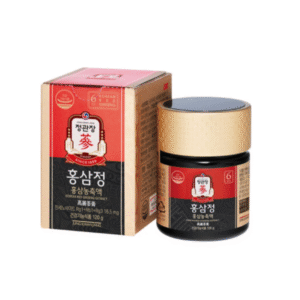Maintaining stable blood sugar levels is one of the most important foundations of long-term health. Unstable glucose levels can lead to energy crashes, inflammation, and over time, increase the risk of insulin resistance, prediabetes, and type 2 diabetes.
While diet and exercise remain the cornerstones of glucose management, research increasingly highlights a natural herbal ally: Korean Red Ginseng (Panax ginseng C.A. Meyer).
Renowned for its adaptogenic and metabolic benefits, Korean Red Ginseng helps regulate blood sugar, enhance insulin sensitivity, and protect pancreatic function — all backed by modern scientific studies.
1. The Link Between Blood Sugar and Energy Balance
Every cell in the body depends on glucose for energy. However, when blood sugar levels rise too high — often due to processed foods, stress, or lack of exercise — the body’s insulin response weakens.
This condition, known as insulin resistance, causes fatigue, weight gain, and inflammation.
Korean Red Ginseng works by addressing these metabolic imbalances at a cellular level, helping the body use glucose more efficiently and maintain stable energy throughout the day.
2. How Korean Red Ginseng Helps Regulate Blood Sugar
The key to red ginseng’s effect on glucose metabolism lies in its bioactive compounds called ginsenosides, particularly Rb1, Rg1, and Rg3.
These compounds influence several metabolic pathways involved in blood sugar regulation:
- 🧬 Enhancing insulin sensitivity:
Ginsenosides improve insulin receptor function, allowing cells to absorb glucose more effectively. - 💡 Reducing glucose absorption in the intestines:
Korean Red Ginseng helps slow down carbohydrate digestion, preventing spikes in post-meal blood sugar. - 🔋 Stimulating glucose uptake in muscle tissue:
By activating AMPK (adenosine monophosphate-activated protein kinase) — the body’s metabolic “energy switch” — red ginseng encourages glucose utilization for energy instead of fat storage.
A randomized clinical trial published in Phytomedicine (2018) showed that subjects taking Korean Red Ginseng extract for 8 weeks experienced a significant reduction in fasting blood glucose and improved insulin sensitivity compared to placebo.
3. Protecting the Pancreas and Beta Cells
The pancreas is responsible for producing insulin. Chronic high blood sugar can damage its beta cells, impairing insulin secretion.
Research has found that Korean Red Ginseng protects pancreatic beta cells from oxidative stress and inflammation, two major factors in diabetes progression.
A 2020 study in the Journal of Ginseng Research demonstrated that ginsenoside Rb1 reduced oxidative damage in pancreatic tissue and improved insulin secretion in animal models of type 2 diabetes.
These findings suggest that red ginseng not only regulates glucose — it may also help preserve pancreatic function in the long run.
4. Combating Inflammation and Oxidative Stress
High blood sugar promotes chronic inflammation, which worsens insulin resistance.
Korean Red Ginseng’s strong anti-inflammatory and antioxidant properties make it a valuable tool for metabolic health.
Ginsenosides suppress inflammatory markers such as TNF-α, IL-1β, and IL-6, while neutralizing harmful free radicals.
This dual action helps the body maintain a healthier internal environment for insulin signaling and glucose control.
🧪 According to a review in Nutrients (2021), red ginseng supplementation significantly improved inflammatory and oxidative biomarkers in people with metabolic syndrome.
5. Supporting Weight Management and Energy Stability
Weight gain, especially around the abdomen, is closely linked to insulin resistance.
Korean Red Ginseng helps regulate appetite hormones and supports fat metabolism, promoting better weight control.
By balancing energy use and reducing glucose fluctuations, users often report more stable energy, reduced cravings, and less fatigue throughout the day.
Its adaptogenic nature also means it supports stress balance — a key factor since elevated cortisol levels can raise blood sugar levels.
6. How to Use Korean Red Ginseng for Blood Sugar Support
Consistency and product quality are essential.
- Dosage: 200–400 mg of standardized red ginseng extract daily, or 1–2 grams of steamed 6-year-old ginseng root.
- Form: Capsules, powders, or concentrated tonics made from Panax ginseng C.A. Meyer.
- Timing: Best taken before meals or in the morning.
Combine with a low-glycemic diet, regular physical activity, and adequate hydration for optimal results.
7. Safe and Evidence-Based Supplementation
Korean Red Ginseng is well-tolerated in most people when used within recommended doses.
However, those taking anti-diabetic medication should consult their healthcare provider, as ginseng may enhance medication effects and lower blood sugar further.
Multiple systematic reviews and meta-analyses confirm that Korean Red Ginseng is a safe and effective complementary approach for managing glucose metabolism and insulin sensitivity.
Conclusion
Korean Red Ginseng offers a holistic, natural approach to blood sugar balance.
Through mechanisms that enhance insulin function, reduce inflammation, and protect pancreatic cells, it provides multi-dimensional support for metabolic health.
For individuals seeking to balance blood sugar naturally and sustainably, Korean Red Ginseng stands as one of the most researched and reliable herbal allies — bridging ancient wisdom with modern science.
🇰🇷 Premium Korean Ginseng Online Shop







